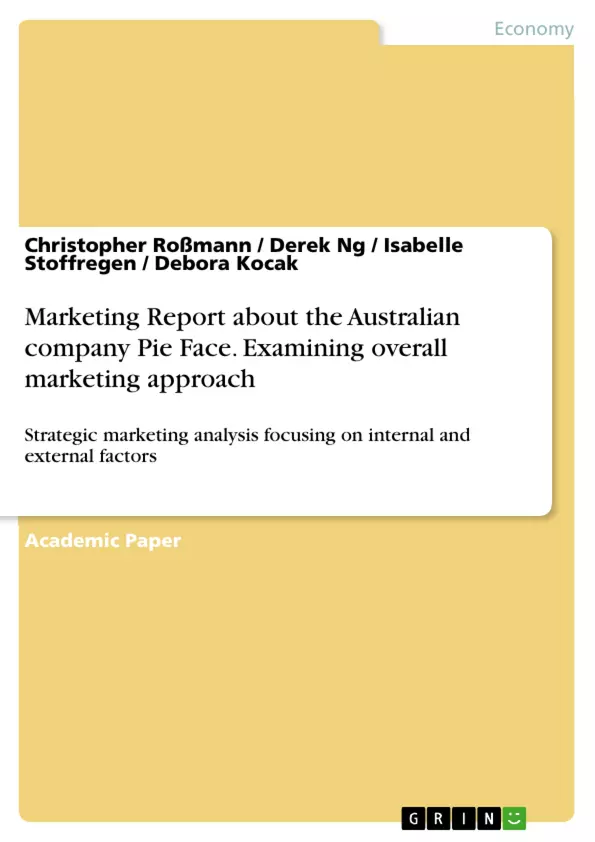The Australian pie company "Pie Face" was examined and evaluated through applying marketing strategies. Finally, recommendations for focusing on a certain strategy and general implications are made in the paper.
Group project assignment for this paper was to describe the target market of the brand and prepare a perceptual map of the market, to briefly conduct an environmental scan by describing the key social, demographic, economic, technological, political/legal and competitive factors that affect the brand’s business and to identify and discuss two internal factors (personal/psychological) and two external factors (social/cultural/situational) that affect the choice of the brand.
Furthermore to discuss the current Integrated Marketing Communication (IMC) campaign of the brand.
What are the IMC tools and media that the brand is currently using? How effective are these tools in creating a positive attitude towards the brand considering the target market of the brand?
Inhaltsverzeichnis (Table of Contents)
- Pie Face: Company Introduction
- Target Market
- Perceptual Map
- Environmental Factors Analysis
- Social
- Demographic/Geographic
- Economic
- Technological
- Political/Legal
- Analysis of Internal and External Factors
- Internal Factors
- Personal Factors
- Psychological factors
- External Factors
- Cultural factors
- Social Factors
- Integrated Marketing Communication (IMC)
- Evaluation
- Differentiation
- Overall cost leadership
- Focus
- General Recommendations for Pie Face to Implement
- Sustainability
- Crisis Management
- Technology
- Social Media and Brand Name
- Alterations of Advertisement
- Strategy recommendation
Zielsetzung und Themenschwerpunkte (Objectives and Key Themes)
This marketing report aims to provide a comprehensive analysis of Pie Face, a fast food restaurant chain, and to develop effective marketing strategies for the company. The report examines both internal and external factors that influence the company's success.
- Target market analysis and segmentation
- Competitive landscape and positioning
- Environmental factors influencing Pie Face's operations
- Marketing strategy development and implementation
- Sustainability and crisis management considerations
Zusammenfassung der Kapitel (Chapter Summaries)
- Pie Face: Company Introduction: This chapter provides a brief overview of Pie Face, its history, and its current position in the fast food market.
- Target Market: This chapter analyzes Pie Face's target market, identifying key demographic and psychographic characteristics of its customers.
- Perceptual Map: This chapter presents a visual representation of Pie Face's position in the market relative to its competitors, highlighting its strengths and weaknesses.
- Environmental Factors Analysis: This chapter examines the various external factors that influence Pie Face's operations, including social, demographic, economic, technological, and political/legal considerations.
- Analysis of Internal and External Factors: This chapter delves into both internal and external factors affecting Pie Face's performance, analyzing personal and psychological factors, as well as cultural and social influences.
- Integrated Marketing Communication (IMC): This chapter discusses Pie Face's current IMC strategy, analyzing its effectiveness and identifying areas for improvement.
- Evaluation: This chapter evaluates different marketing strategies, including differentiation, overall cost leadership, and focus, to determine their suitability for Pie Face.
- General Recommendations for Pie Face to Implement: This chapter presents specific recommendations for Pie Face to implement in order to enhance its marketing strategy, improve sustainability, and effectively manage potential crises.
Schlüsselwörter (Keywords)
The report centers on key concepts such as target market analysis, competitive analysis, environmental factors, marketing strategy, integrated marketing communication, differentiation, cost leadership, focus, sustainability, and crisis management.
- Quote paper
- Christopher Roßmann (Author), Derek Ng (Author), Isabelle Stoffregen (Author), Debora Kocak (Author), 2018, Marketing Report about the Australian company Pie Face. Examining overall marketing approach, Munich, GRIN Verlag, https://www.grin.com/document/468958



